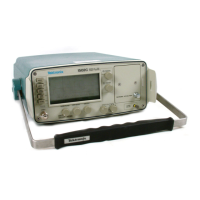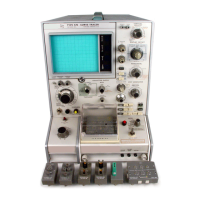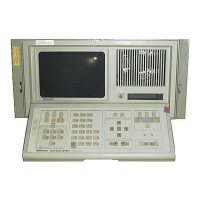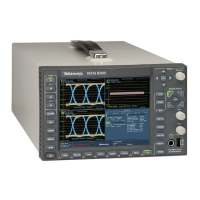Theory of Operation
4–14
1720/1721
U942 is a Quad Operational Amplifier. U942A and B are Balanced Differential
Input Amplifiers, intended for audio use. In a 600Ω system, R846 and R948 can
be adjusted to normalize signals from 0 dBm to +12 dBm (2 V p-to-p to 9 V
p-to-p). The input impedance is greater than 20 kΩ to ground.
J920 and J921 can be installed so that the plus inputs of the X and Y amplifiers
are connected to the high gain X and Y ports. These ports are provided for
special non-audio applications where a higher gain may be needed.
U942D and C drive the X and Y Deflection Amplifiers through a Microproces-
sor-controlled switch, U585. A small amount of Y signal is fed through R847 to
the X Amplifier for the orthogonality adjustment.
The Vertical Deflection Amplifier consists of Q580 and Q581 (a differential pair)
with Q480 and Q481 (grounded base amplifiers) that speed up the amplifiers by
minimizing the miller capacitance on Q580 and Q581. CR474, CR476, CR484,
and CR486 prevent Q480 and Q481 from saturating when the amplifier is
overdriven by large signals. Q474 and Q576 are the current source for the
differential pair. The Horizontal Deflection Amplifier is similar in operation to
the Vertical Deflection Amplifier.
The orthogonality control feeds Y signals into the –input of the Horizontal
Deflection Amplifier. Both the vector and XY circuits feed +2% Y signals into
the X signal, for use in orthogonality compensation. Adjusting the orthogonality
control cancels out some or all of the Y signal in the X Amplifier. The effect of
this control is to change the deflection angle between the X and Y axis to
compensate for crt geometry.
U446 is a quad comparator with open collector outputs that are tied together.
When both the X and Y signals are close to 0 V (no signal with only a center
dot), the output of all the comparators is high and C349 discharges in the
positive direction toward ground. If either the X or Y signal is away from 0 V,
the output of at least one of the comparators will be low (–6 V), charging C349.
The output of the comparators drives a common base stage, Q541. When the
collector of Q541 is high, the crt is blanked. P245 can be installed to disable the
crt blanking. Q343 is turned on by the H pulse to unblank the crt long enough
for the center dot to be visible if there is no signal. When the base of Q540 is
pulled high the crt is blanked. Q424, when turned off by the Microprocessor,
blanks the crt during dynamic switching between the XY and VECT modes. The
line select blanking signal originates in the 1730-Series when it is a companion
to the 1720/ 1721. When Line Sel Blank is high, the crt is blanked and the line
select brightup circuitry is enabled. The line select blanking signal is low during
the selected line to unblank the crt for that line. Q248 enables the brightup
circuitry. CR137 and C239 keep the brightup circuitry enabled during the time
that the Line Sel Blank is low to unblank the crt during the selected line.
XY Input Amps
Deflection Amplifiers
Center Dot Comparators
CRT Blanking
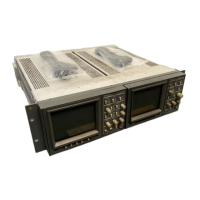
